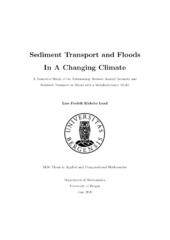Sediment Transport and Floods In A Changing Climate
Master thesis
Permanent lenke
https://hdl.handle.net/1956/22649Utgivelsesdato
2020-06-17Metadata
Vis full innførselSamlinger
- Master theses [120]
Sammendrag
Rainfall intensity and river flood magnitudes in Norway are expected to increase in the near future due to climate change. This thesis investigates the morphological impacts this increase in rainfall intensity will have on pluvial river flood events. The 2-D numerical morphologic model FINEL2D is applied to 3 scenarios, with 5-hour rainfall courses of different intensities. To explore the differences between hydrologic and morphologic models, parallel simulations with the morphologic module turned off are carried out for comparison. Special attention is given to the effect that differences in slope in a river have on sediment transport. Reliability of morphologic models, and their applications in river flood maps, are discussed. The simulation results imply an exponential relationship between rainfall intensity and sediment transport in rivers. A 50% increase in rainfall intensity results in a doubling of transported sediment. The differences between a morphologic and hydrologic simulation amounts to significant variations in flood-levels and flow extension based on the terrain and river layout. Differences in slope is identified as a driving factor of morphological changes. Sediment is eroded from steep segments of a river and causes sedimentation in flatter areas. The model strives towards an equilibrium in flow conditions, and thus flattens out differences in slopes. Morphological models are able to accurately hindcast morphological changes over time. It is argued that the behavior of morphological models to find an equilibrium, makes them in large part able to predict morphological changes in a flood event. Even with the strong non-linear behavior and added uncertainties, a morphologic model has several benefits over a hydrologic model, making them potentially valuable in flood maps. The importance of morphological models may become even more relevant with a future increase in rainfall intensity caused by climate change, which results in larger morphological changes in a flood event.
